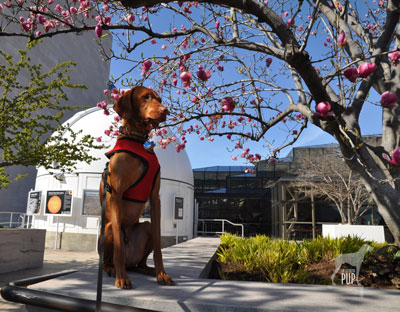 With all the recent talk of feisty solar flares amping up the activity of the Northern Lights and having the potential to wreak a little havoc with power grids and GPS devices here on Earth, the Intrepid Pup turns his attentions to the firmament. And what better place to whet one’s celestial appetite than the Smithsonian’s National Air and Space Museum?
With all the recent talk of feisty solar flares amping up the activity of the Northern Lights and having the potential to wreak a little havoc with power grids and GPS devices here on Earth, the Intrepid Pup turns his attentions to the firmament. And what better place to whet one’s celestial appetite than the Smithsonian’s National Air and Space Museum?
Except…we’re directing your attention not to the museum’s exhibition galleries that are literally among the most visited in the world but rather to its lesser-known but not-so-little nub of an astronomical observatory that rests upon the museum’s outdoor east terrace right on Washington, DC’s National Mall.
The Public Observatory Project (POP) is the tangible manifestation of a dream long-held by Dr. David DeVorkin, the museum’s senior curator of astronomy and space sciences. To know DeVorkin is also to know that he’s an enthusiastic proponent of making astronomy accessible. “The Mall has its monuments,” he wrote back in 2009, “What it needs is a portal, a portal to the universe.” The idea was to put a telescope where people—slews of them!—already are, thereby igniting interest in astronomy among casual observers. It didn’t quite take an act of Congress, but it did require a dedicated project team and approvals from the museum, the U.S. Commission of Fine Arts, and the National Capital Planning Commission. Dream became reality when the observatory opened in October 2009 to coincide with the International Year of Astronomy. The observatory’s workhorse is a 16-inch Boller & Chivens telescope re-purposed from Harvard-Smithsonian’s Oak Ridge Observatory in Massachusetts, but staffers also keep several smaller hand-held telescopes at the ready for visitors. The observatory is free and open to the public, though operating hours are highly weather dependent, so check POP’s Twitter feed for updates. For daytime viewing, you’ll be training the telescopes to look at moon craters, the phases of Venus, and yes,—with the aid of safe solar filters—sunspots! Now you can see for yourself what the sun is up to.
Dogging the Details
38°53′16.26″N, 77°1′6.67″W
Public Observatory, Smithsonian Institution’s National Air and Space Museum, Washington DC
 The observatory scores a “1” on the Wag-a-meter as it’s pretty darn accessible. Parking during the day can be problematic as there are no big public parking lots close by, but there are metered spaces along Independence Avenue and side streets, and the L’Enfant Plaza and Smithsonian Metro stations are both within easy walking distance.
The observatory scores a “1” on the Wag-a-meter as it’s pretty darn accessible. Parking during the day can be problematic as there are no big public parking lots close by, but there are metered spaces along Independence Avenue and side streets, and the L’Enfant Plaza and Smithsonian Metro stations are both within easy walking distance.
Alas, your dog can’t hang out in the observatory and would likely have trouble peering through the telescope’s eyepiece even if he could. Yet if you’re out on a walk with your dog, there are informative panels to read on the observatory’s exterior, and when the observatory is open to visitors, astronomy educators are often right by the door and will gladly field your questions.
If you happen to go stargazing on one of POP’s special nighttime observation evenings, ask the staff if you can take a gander at Canis Major (a constellation representing one of the great hunter Orion’s dogs)…and tell them the Intrepid Pup sent you.










